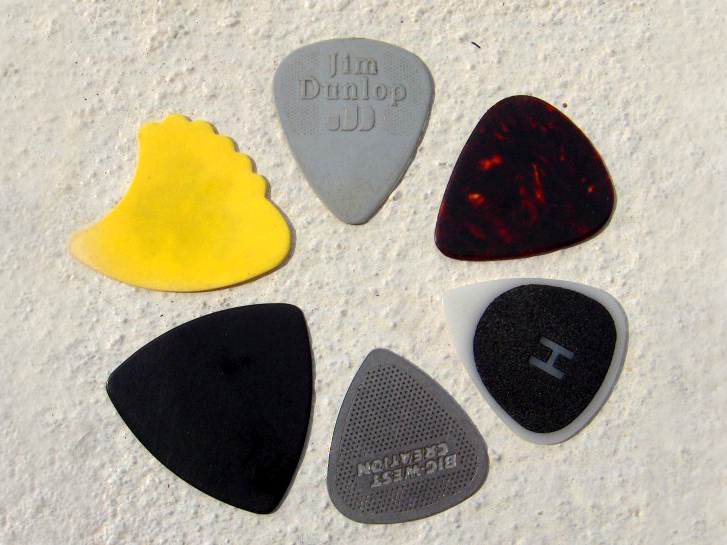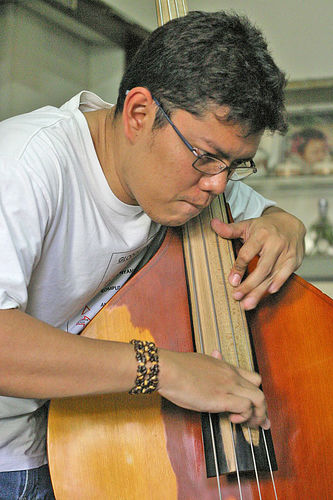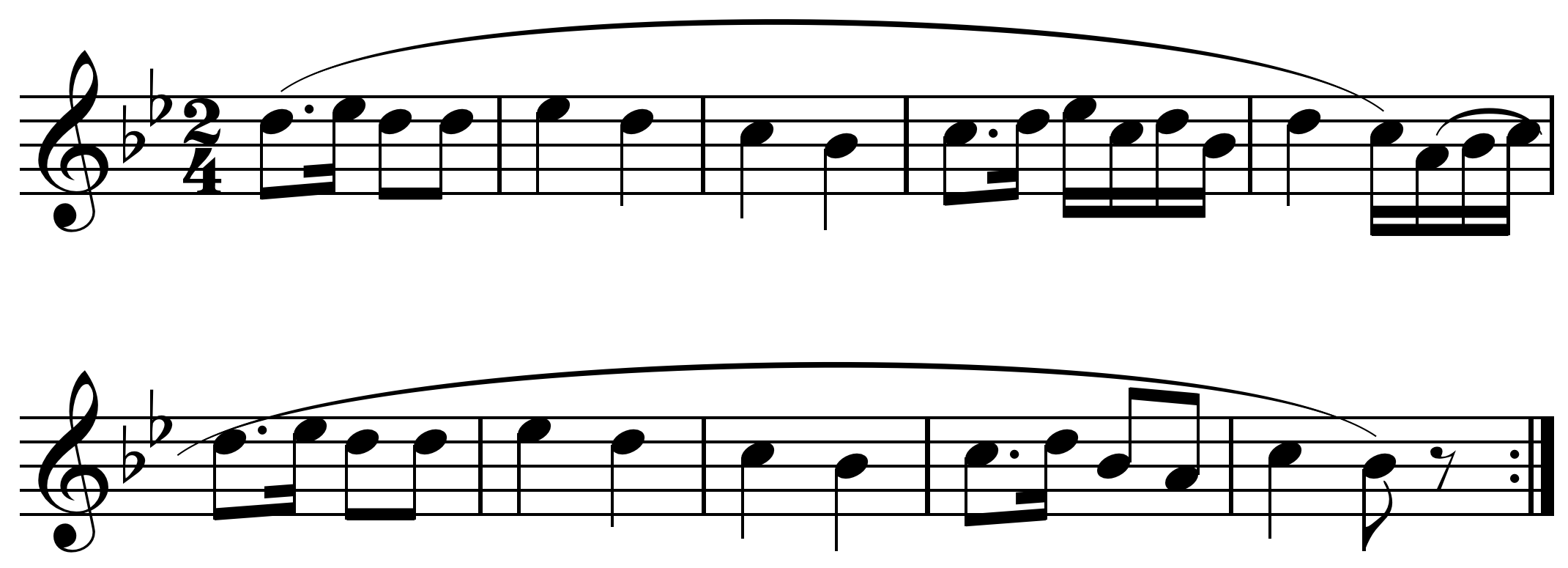|
Hammer-ons
A hammer-on is a playing technique performed on a stringed instrument (especially on a fretted string instrument, such as a guitar) by sharply bringing a fretting-hand finger down on to the fingerboard behind a fret, causing a note to sound. This technique is the opposite of the pull-off. Passages in which a large proportion of the notes are performed as hammer-ons and pull-offs instead of being plucked or picked in the usual fashion are known in classical terminology as ''legato'' phrases. The sound is smoother and more connected than in a normally picked phrase, due to the absence of the necessity to synchronize the plucking of one hand with the fingering on the fingerboard with the other hand; however, the resulting sounds are not as brightly audible, precisely due to the absence of the plucking of the string, the vibration of the string from an earlier plucking dying off. The technique also facilitates very fast playing because the picking hand does not have to move at such ... [...More Info...] [...Related Items...] OR: [Wikipedia] [Google] [Baidu] |
Legato
In music performance and notation, legato (; Italian for "tied together"; French ''lié''; German ''gebunden'') indicates that musical notes are played or sung smoothly, such that the transition from note to note is made with no intervening silence. Legato technique is required for slurred performance, but unlike slurring (as that term is interpreted for some instruments), legato does not forbid articulating the notes with a very slight interruption. Standard notation indicates legato either with the word ''legato'', or by a slur (a curved line) under notes that form one legato group. The latter notation is differentiated from a tie in that the notes have different pitches. Legato, like staccato, is a kind of articulation. There is an intermediate articulation called either ''mezzo staccato'' or ''non-legato'' (sometimes referred to as '' portato''). Classical string instruments In music for Classical string instruments, legato is an articulation that often refers to notes ... [...More Info...] [...Related Items...] OR: [Wikipedia] [Google] [Baidu] |
Pull-off
A pull-off is a stringed instrument playing and articulation technique performed by plucking or "pulling" the finger that is grasping the sounding part of a string off the fingerboard of either a fretted or unfretted instrument. This intermediate- to advanced playing technique is done using the tip of a finger or fingernail on the fretting hand. Pull-offs are done to facilitate the playing of embellishments and ornaments such as grace notes. Pull-offs may be notated in sheet music or improvised by the performer, depending on the musical style and context. Performance and effect A pull-off is performed on a string which is already vibrating; when the fretting finger is pulled off (exposing the string either as open or as stopped by another fretting finger "lower" on the same string, with "lower" meaning in a position that is lower in pitch) the note playing on the string changes to the new, longer vibrating length of the string. Pull-offs are performed on both fretted instrument ... [...More Info...] [...Related Items...] OR: [Wikipedia] [Google] [Baidu] |
Guitar Picking
Guitar picking is a group of hand and finger techniques a guitarist uses to set guitar strings in motion to produce audible notes. These techniques involve plucking, strumming, brushing, etc. Picking can be done with: * A plectrum, pick (plectrum) held in the hand * Natural or artificial fingernails, fingertips or finger-mounted plectrums known as fingerpicks (for techniques collectively known as fingerstyle) * A plectrum held between thumb and one finger, supplemented by the free fingers—called hybrid picking or sometimes "chicken pickin". Using a single thumb pick with the bare fingers is similar to hybrid picking. Another mixed technique is to play different passages with a plectrum or fingerstyle, "palming" the plectrum when not in use. This however requires the use of one or more picking hand fingers, and/or can reduce dexterity in the picking hand. Comparison of plectrum and finger picking techniques The pros of each guitar picking style are indirectly correlated to th ... [...More Info...] [...Related Items...] OR: [Wikipedia] [Google] [Baidu] |
Shred Guitar
Shred guitar is a virtuosic style of electric guitar performance. Categorized by its use of advanced techniques, shredding is a complex art form. Shred guitar includes fast alternate picking, sweep-picking, diminished and harmonic minor scales, tapping, and whammy bar use. Often incorporated in heavy metal, guitarists employ a guitar amplifier and a range of effects such as distortion. This creates a sustained guitar tone and may facilitate guitar feedback. The term is sometimes used in reference to virtuosic playing by instrumentalists other than guitarists as well. The term "shred" is used outside the metal idiom, particularly by bluegrass musicians and jazz-rock fusion electric guitarists. History Many jazz guitarists in the 1950s such as Les Paul, Barney Kessel and Tal Farlow used an improvised technique by raking the pick across the strings to play a rapid succession of notes, today known as sweep picking. Les Paul's performance of " How High the Moon" contained s ... [...More Info...] [...Related Items...] OR: [Wikipedia] [Google] [Baidu] |
Fingerboard
The fingerboard (also known as a fretboard on fretted instruments) is an important component of most stringed instruments. It is a thin, long strip of material, usually wood, that is laminated to the front of the neck of an instrument. The strings run over the fingerboard, between the nut and bridge. To play the instrument, a musician presses strings down to the fingerboard to change the vibrating length, changing the pitch. This is called '' stopping'' the strings. Depending on the instrument and the style of music, the musician may pluck, strum or bow one or more strings with the hand that is not fretting the notes. On some instruments, notes can be sounded by the fretting hand alone, such as with hammer ons, an electric guitar technique. The word "fingerboard" in other languages sometimes occurs in musical directions. In particular, the direction ''sul tasto'' (Ital., also ''sulla tastiera'', Fr. ''sur la touche'', G. ''am Griffbrett'') for bowed string instruments to pla ... [...More Info...] [...Related Items...] OR: [Wikipedia] [Google] [Baidu] |
Musical Note
In music, notes are distinct and isolatable sounds that act as the most basic building blocks for nearly all of music. This musical analysis#Discretization, discretization facilitates performance, comprehension, and musical analysis, analysis. Notes may be visually communicated by writing them in musical notation. Notes can distinguish the general pitch class or the specific Pitch (music), pitch played by a pitched Musical instrument, instrument. Although this article focuses on pitch, notes for unpitched percussion instruments distinguish between different percussion instruments (and/or different manners to sound them) instead of pitch. Note value expresses the relative Duration (music), duration of the note in time. Dynamics (music), Dynamics for a note indicate how Loudness, loud to play them. Articulation (music), Articulations may further indicate how performers should shape the Envelope (music), attack and decay of the note and express fluctuations in a note's timbre and Pit ... [...More Info...] [...Related Items...] OR: [Wikipedia] [Google] [Baidu] |
Guitar
The guitar is a stringed musical instrument that is usually fretted (with Fretless guitar, some exceptions) and typically has six or Twelve-string guitar, twelve strings. It is usually held flat against the player's body and played by strumming or Plucked string instrument, plucking the strings with the dominant hand, while simultaneously pressing selected strings against frets with the fingers of the opposite hand. A guitar pick may also be used to strike the strings. The sound of the guitar is projected either Acoustics, acoustically, by means of a resonant hollow chamber on the guitar, or Amplified music, amplified by an electronic Pickup (music technology), pickup and an guitar amplifier, amplifier. The guitar is classified as a chordophone, meaning the sound is produced by a vibrating string stretched between two fixed points. Historically, a guitar was constructed from wood, with its strings made of catgut. Steel guitar strings were introduced near the end of the nineteen ... [...More Info...] [...Related Items...] OR: [Wikipedia] [Google] [Baidu] |
Pizzicato
Pizzicato (, ; translated as 'pinched', and sometimes roughly as 'plucked') is a playing technique that involves plucking the strings of a string instrument. The exact technique varies somewhat depending on the type of instrument: * On bowed string instruments it is a method of playing by plucking the strings with the fingers, rather than using the bow. This produces a very different sound from bowing, short and percussive rather than sustained. * On keyboard string instruments, such as the piano, pizzicato may be employed (although rarely seen in traditional repertoire, this technique has been normalized in contemporary music, with ample examples by George Crumb, Tōru Takemitsu, Helmut Lachenmann, and others) as one of the variety of techniques involving direct manipulation of the strings known collectively as " string piano". * On the guitar, it is a muted form of plucking, which bears an audible resemblance to pizzicato on a bowed string instrument with its relatively ... [...More Info...] [...Related Items...] OR: [Wikipedia] [Google] [Baidu] |
Plectrum
A plectrum is a small flat tool used for plucking or strumming of a stringed instrument. For hand-held instruments such as guitars and mandolins, the plectrum is often called a pick and is held as a separate tool in the player's hand. In harpsichords, the plectra are attached to the jack mechanism. Plectra wielded by hand Guitars and similar instruments A plectrum for electric guitars, acoustic guitars, bass guitars and mandolins is typically a thin piece of plastic or other material most commonly shaped like a pointed teardrop or triangle, though the size, gauge, shape and width may vary considerably. Banjo and guitar players may wear a metal or plastic thumb pick mounted on a ring, and bluegrass banjo players often wear metal or plastic fingerpicks on their fingertips. Many guitarists use fingerpicks as well. Guitar picks are made of a variety of materials, including celluloid, metal, and rarely other exotic materials such as turtle shell, but today delrin (a synthetic ... [...More Info...] [...Related Items...] OR: [Wikipedia] [Google] [Baidu] |
Stringed Instrument
In musical instrument classification, string instruments, or chordophones, are musical instruments that produce sound from vibrating strings when a performer strums, plucks, strikes or sounds the strings in varying manners. Musicians play some string instruments, like guitars, by plucking the strings with their fingers or a plectrum (pick), and others by hitting the strings with a light wooden hammer or by rubbing the strings with a bow, like violins. In some keyboard instruments, such as the harpsichord, the musician presses a key that plucks the string. Other musical instruments generate sound by striking the string. With bowed instruments, the player pulls a rosined horsehair bow across the strings, causing them to vibrate. With a hurdy-gurdy, the musician cranks a wheel whose rosined edge touches the strings. Bowed instruments include the string section instruments of the orchestra in Western classical music (violin, viola, cello and double bass) and a number of ... [...More Info...] [...Related Items...] OR: [Wikipedia] [Google] [Baidu] |
Phrase (music)
In music theory, a phrase () is a unit of Meter (music), musical meter that has a complete musical sense of its own, built from figure (music), figures, motif (music), motifs, and Cell (music), cells, and combining to form Melody, melodies, period (music), periods and larger Section (music), sections. Terms such as ''sentence'' and ''verse'' have been adopted into the vocabulary of music from linguistic syntax. Though the analogy between the musical and the phrase, linguistic phrase is often made, still the term "is one of the most ambiguous in music....there is no consistency in applying these terms nor can there be...only with melodies of a very simple type, especially those of some dances, can the terms be used with some consistency." John D. White defines a phrase as "the smallest musical unit that conveys a more or less complete musical thought. Phrases vary in length and are terminated at a point of full or partial repose, which is called a ''cadence''." Edward T. Cone, ... [...More Info...] [...Related Items...] OR: [Wikipedia] [Google] [Baidu] |
Banjo Roll
In bluegrass music, a banjo roll or roll is a pattern played by the banjo that uses a repeating eighth-note arpeggio – a broken chord – that by subdividing the beat 'keeps time'. "Each standard"roll pattern is a ''right hand'' fingering pattern, consisting of eight (eighth) notes, which can be played while holding ''any'' chord position with the left hand." "When used as back-up, the same pattern can be repeated over and over throughout an entire song, (... ith chord changesas required), or the roll patterns can be combined with one another and with ack-up licks.. The roll patterns can also be used to embellish the vamping style of back-up, especially when the chords are played high... These roll patterns can be used as back-up for any song played at any tempo." The banjo is commonly played in open tunings, such as open G (as are all of the examples): G′DGBD′, allowing rolls to be practiced on all open strings (without fretting). Rolls are a distinguishing cha ... [...More Info...] [...Related Items...] OR: [Wikipedia] [Google] [Baidu] |







